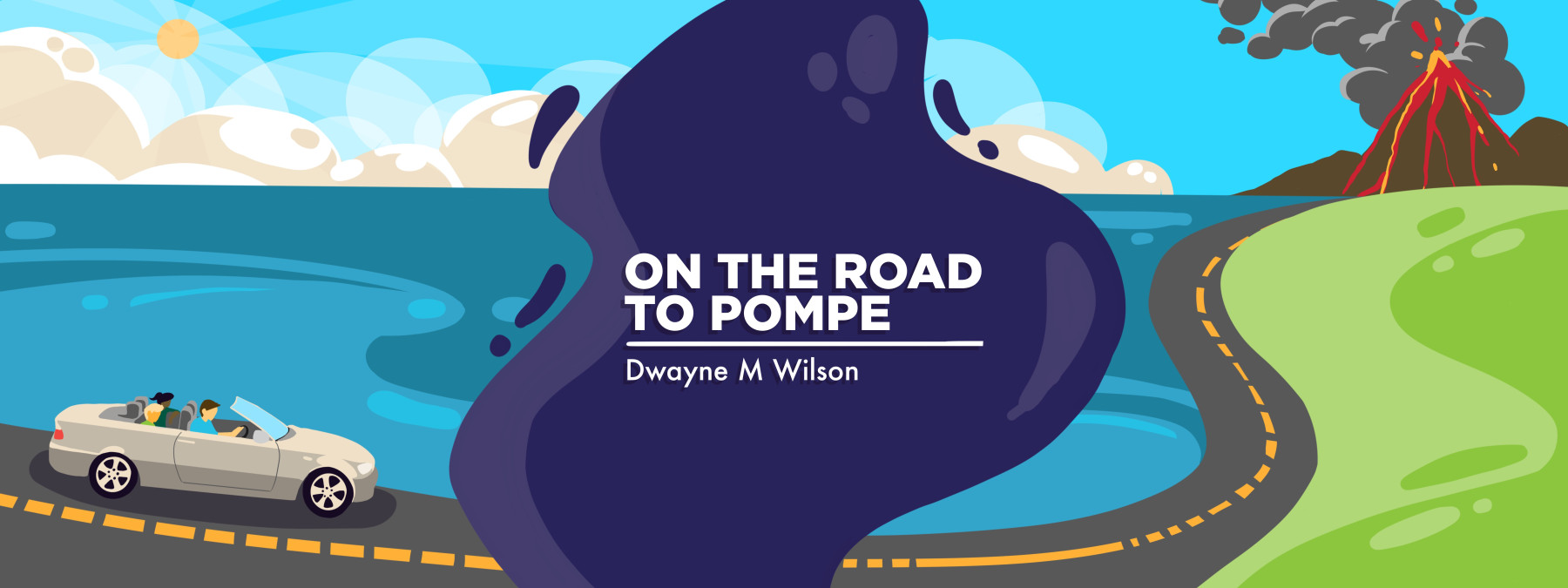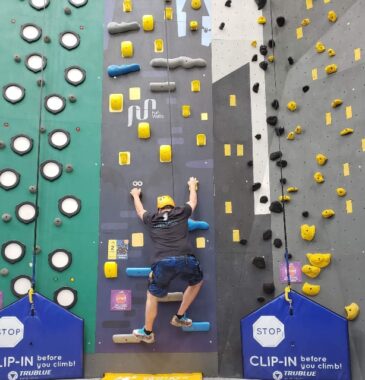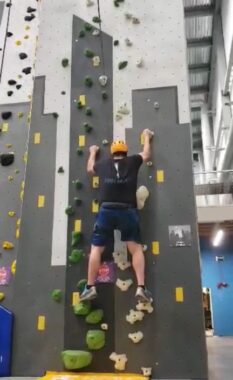Can the guy in a wheelchair actually go wall climbing? Why not?
Eager for adventure, a columnist transcends what he thought were his limits

This past week, my best friend, Joe, and his son Dane came from Montana to visit me in California. I decided to take Monday off from work to meet up with them so I could watch Dane, an adventurous young man, as he went rock climbing. In fact, he’s been in competitions and was looking forward to taking on some climbing in nearby Joshua Tree National Park.
But with the cold, rainy weather that we were experiencing, they decided to find an indoor climbing facility instead.
We were leaving our home to meet them at Sender One SNA in Santa Ana, California, when I was informed that there’d only be benches to sit on. Having late-onset Pompe disease keeps me on my toes when going to public places, so I try to prepare for whatever level of accessibility they have.
Since there were no comfortable places to sit and we’d be there for hours, I loaded up my electric wheelchair, which I call the Dolphinator, just to have a good seat.
Conquering self-doubt
After I rolled into the entrance, we met up with our friends, signed some waivers, and started our tour. Sitting in the Dolphinator, I watched Dane climb. After a while, I got out of my wheelchair and walked onto the mat, approaching a dinosaur-themed climbing wall. I posed with my hands on some footrests and asked my wife to take a photo of me pretending to climb.
I sat back down in the wheelchair and watched a few others climb one of the many walls. Then Dane and my wife had an idea: Wouldn’t it be fun if the staff could strap the rope to my wheelchair and haul me up? The staff member with our group had another idea: The rope machines held 300 pounds, and if I could fit into a harness, I could try to actually climb.
Of course, my first reaction was “No, I’m fine.” I thought there was no way I could climb a wall. My muscles were too weak, I had no strength, and I wouldn’t fit in a harness. It’d be a waste of time. Self-doubt ran through my brain.
But the staff member asked me to check if I fit into the harness, and I went along with it.
I walked into a room where climbers suit up, sitting on a bench. I put my legs through the harness, tightened it around my waist, then tightened each leg strap. Well, I did fit in the harness.
Then the staff member said I could climb if I wanted, and that she’d even share her guest day pass with me to make it legit. My wife said, “Go for it! You only live once.” My mind, however, was thinking, “Why would you offer the guy in a wheelchair a free pass to climb?”
Then I answered my own question: “Why not?”

Dwayne Wilson begins his climb, strapped into a wall-climbing harness and wearing a safety helmet. (Photo by Jean Gibson)
I put on a helmet and was ready to go. At 6 feet, 5 inches tall and weighing 290 pounds, I’m not the most graceful guy. The old saying “The bigger they are, the harder they fall” was written with me in mind. But never had I been harnessed into wall-climbing equipment. Soon I was letting go of all my fears about climbing walls with a rare muscle disease. I was living in the moment.
After the staff member gave me some instructions, I clipped into the auto-belay device, which would slowly lower me to the ground if I made it to the top. I started my efforts to ascend into the sky. Maybe if I’d had rock-climbing shoes, I would’ve made it up a little farther, but I was proud of myself. I got higher than I thought I could.

Dwayne Wilson furthers his ascent. (Photo by Jean Gibson)
I tried two other climbing walls, but decided my body was telling me three tries were enough success for my first time at the sport. Even when falling to the mat, I was able to roll onto my side, then rise to my hands and knees before standing on my own. I’d come a long way from when I was diagnosed with late-onset Pompe in November 2018.
The staff member made my day. She was so kind and helpful to give me hope — me, a person who hadn’t been on so much as playground monkey bars since grade school.
This journey “On the Road to Pompe” has been full of bumps and curves, with obstacles scattered along the path. But I’m constantly going forward, now climbing upward, always in motion, looking toward the next thing to experience.
Note: Pompe Disease News is strictly a news and information website about the disease. It does not provide medical advice, diagnosis, or treatment. This content is not intended to be a substitute for professional medical advice, diagnosis, or treatment. Always seek the advice of your physician or other qualified health provider with any questions you may have regarding a medical condition. Never disregard professional medical advice or delay in seeking it because of something you have read on this website. The opinions expressed in this column are not those of Pompe Disease News or its parent company, Bionews, and are intended to spark discussion about issues pertaining to Pompe disease.








Leave a comment
Fill in the required fields to post. Your email address will not be published.